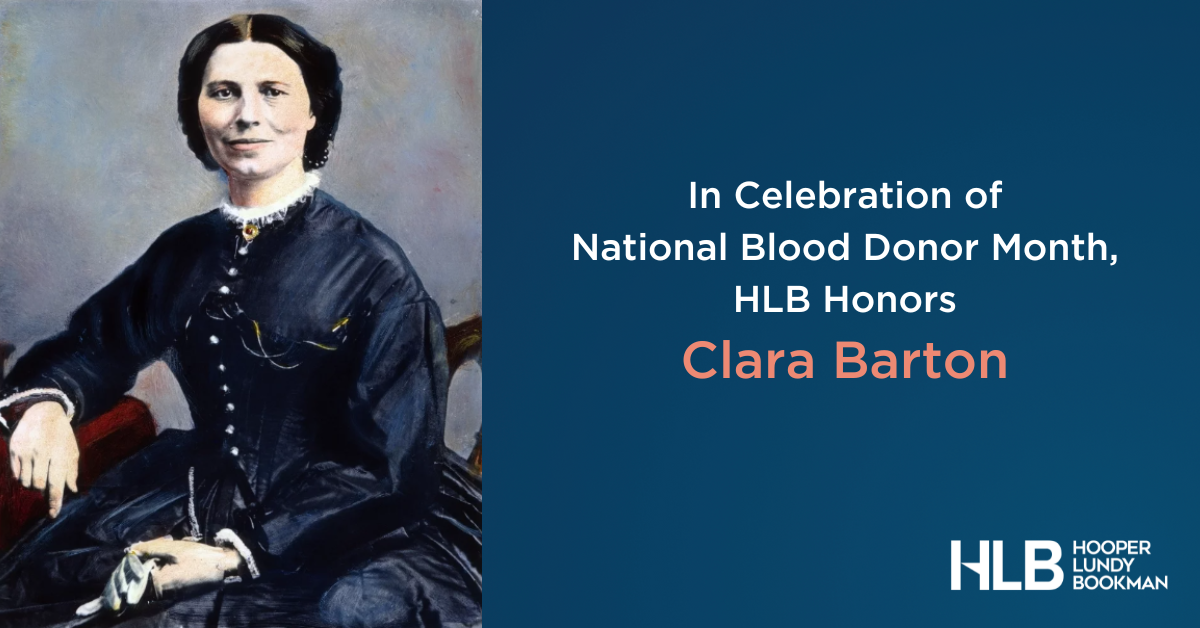
In honor of National Blood Donor Month, Hooper, Lundy & Bookman recognizes the American Red Cross and Clara Barton (1821-1912), humanitarian, nurse and president of the groundbreaking organization.
Nicknamed “the angel of the battlefield,” Barton didn’t shy away from combat areas while providing nursing care and medical supplies to soldiers during the Civil War. “I may be compelled to face danger, but never fear it, and while our soldiers can stand and fight, I can stand and feed and nurse them,” Barton said.
In 1869, Barton visited Switzerland, where she was introduced to the International Red Cross, which endeavored to provide neutral humanitarian aid to those injured in combat. When the Franco-Prussian War broke out in 1870, Barton again visited war zones with volunteers of the International Red Cross, where she helped distribute supplies.
Upon her return to the United States, officials of the International Red Cross in Switzerland recognized Barton for her leadership abilities and for influencing the United States government to sign the Geneva Treaty in 1882. Through a congressional charter, the American Red Cross is charged by the federal government to provide services to members of the American armed forces and their families, as well as to provide disaster relief in the United States and around the world.
Barton ran the American Red Cross for 23 years, resigning as president in 1904. Thereafter, Barton established the National First Aid Association of America (NFAAA) and served as its honorary president for five years. The NFAAA emphasized basic first aid instruction, emergency preparedness and the development of first aid kits. Though the NFAAA was short-lived, the American Red Cross later absorbed the NFAAA’s activities into its own health and safety programs.
The American Red Cross continued to expand after Barton’s tenure, pursuing vital domestic and international projects. In 1912, two years prior to the outbreak of World War I, the organization started a public health nursing program to provide nursing care and first aid education to underserved and rural communities. During that war, the American Red Cross helped staff hospitals and ambulance companies, and also recruited 20,000 registered nurses to serve the U.S. military, both in the United States and abroad.
During World War II, the American Red Cross enrolled 104,000 nurses for military service, shipped supplies overseas and sent packages to American and Allied prisoners of war. It was at this time, at the bequest of the military, that the American Red Cross initiated a national blood program for use by the U.S. military. Following World War II, the American Red Cross created the first nationwide civilian blood program and to date provides more than 40% of the blood products in the United States. Over the years, the American Red Cross has modernized and improved the collection of blood and safety of blood products. Read here to learn more about the history of blood transfusion.
In January 2024, the American Red Cross declared an “emergency blood shortage,” which can have a devastating impact on accident victims, surgical patients, sickle cell patients and cancer patients (the latter receiving almost half of all platelet donations collected). According to Pampee Young, Chief Medical Officer of Biomedical Services of the American Red Cross, “A person needs lifesaving blood every two seconds in the U.S.” If you are interested in donating, schedule an appointment by visiting RedCrossBlood.org, downloading the Red Cross Blood Donor app or calling 1-800-RED CROSS (1-800-733-2767).